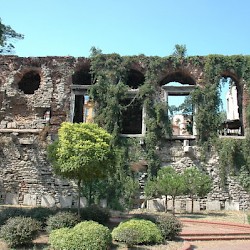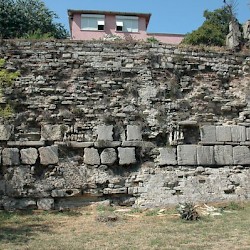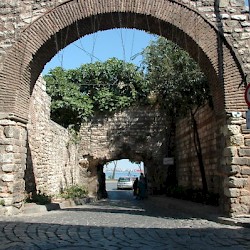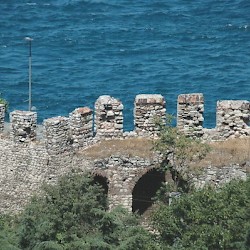Constantinople, Sea Walls
Q89917Constantinople (Κωνσταντινούπολις) or Byzantium (Βυζάντιον): Greek city on the Bosphorus, capital of the Byzantine Empire, modern İstanbul.

The Sea Walls of Constantinople go back to the reign of the emperor Septimius Severus, who sacked the city (which was then known as Byzantium) in 195, and ordered its reconstruction in 203. Parts of these walls still exist, for example in the northeast, below the Topkapı Palace, near the confluence of the Golden Horn and the Bosphorus.
During the reign of Theodosius II, in 439, these walls were improved and expanded to connect them to the Land Walls that been built in 412-414. The design is more or less identical, although the Sea Walls are lower. Further improvement was therefore necessary when the Muslims started to build a navy and conquered Cyprus in the mid-seventh century. In 672, the Arab navy entered the Bosphorus; large catapults threatened the city, but the Byzantines retaliated with "Greek fire", a flaming liquid made - according to Marcus Graecus - of sulfur and petroleum, that destroyed the enemy fleet. In 678, the siege was broken off.
Several later emperors improved the walls. They were made higher and were strengthened with square towers. Often, the builders used spolia (architectural parts from older builders). However, the walls turned out to be the weak spot of the Constantinopolitean defenses: in 1204, the Crusaders breached the Sea Walls and sacked the city.

The photos above show several parts of the southern Sea Wall, which is along the Sea of Marmara and has a length of about 8½ kilometers. The first photo on the top row was taken near the Church of Saint John the Forerunner of Studius, in the southwest of the city. The second and third photo show the fortifications near the Bucoleon Palace, south of the imperial palace. It was famous for its relics, which were believed to help defend the city: in the chapel was a crystal phial that contained some of the blood of Christ. (It is possible that this phial is now in the Flemish city of Bruges.)
Not far from the Bucoleon was the ancient lighthouse, which is seen on the fourth and fifth photos; the modern lighthouse is a stone's throw away from here. After two phoros of gates, the last photo shows the Severan section of the Sea Wall, northeast of the Topkapı Palace, near the confluence of the Bosphorus and the Golden Horn.
The wall along the Golden Horn was about 5½ kilometers long. The beautifully decorated Royal Gates gave access to the Blachernae palace in the northwest.







